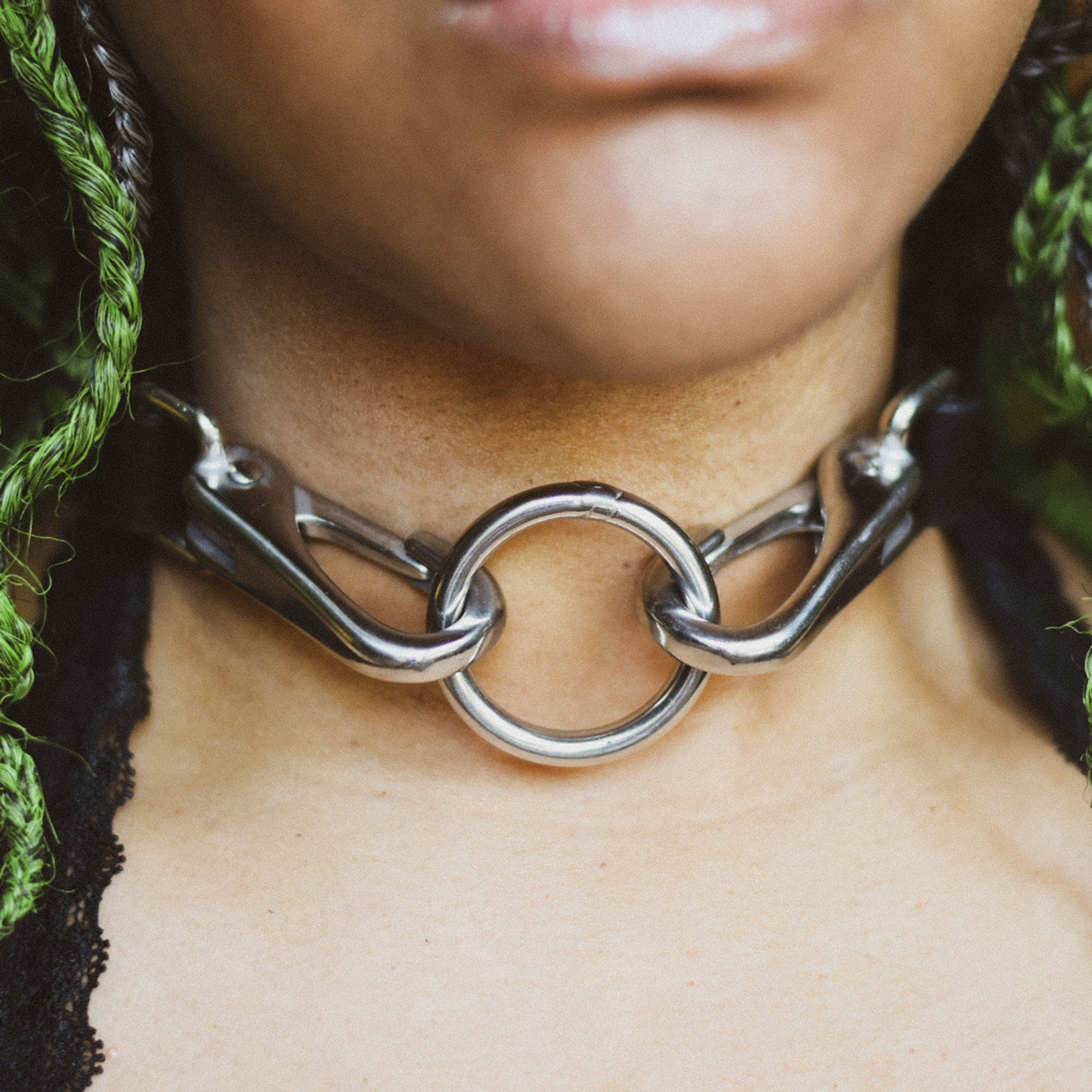Written by Lina Dune.
Photo: Kolby Brianne.
As a 24/7, lifestyle submissive, I often forget how much other people don’t know about the BDSM air I breathe and water I swim in. A lot of people barely know the difference between a whip and a flog, couldn’t tell you what to do with a cane other than walk or tap-dance with it, and don’t know that cuffs aren’t just a statement jewelry piece. The same folks look right at my 24/7 collar, and tell me to my face how much they love my “choker.” This is why BDSM is kind of a secret society, because the learning curve to all the odds and ends of it is so huge. But I’m here to betray my secret society and lay it all bare. And what better place to start than with a story?
When I first arrived in my first real D/s relationship, my Dom made mention of collaring offhandedly and flirtatiously a couple of times. We were still very much in a training period, but it was hinted that a collar might be in my future. I would smile and nod blankly when He brought up the concept, but really didn’t understand what it meant. Every time I came over to do a scene (be spanked, follow high protocol, etc), He’d put a “play collar” on me, but I sensed this was something different. So I did what any good sub would do and I googled until my fingers practically fell off. And the best information that I could find was on a blog from the early 2000’s and basically told me that formal collaring was something of an occult ritual tantamount to engagement. That seemed pretty extreme.
For the modern couple, the simplest way to describe the meaning of a collar is that it signifies the agreement of power exchange for a prescribed amount of time. It could be for the duration of an evening or for an open-ended relationship, or for a lifetime. There are different types of collars which serve different purposes, but in today’s scene—and especially with the ways that fashion has appropriated BDSM accessories—it’s all fair game to be used however makes you happy. In high-protocol environments or play parties, if you see someone wearing a collar, it’s customary not to speak to that person without first consulting their Dominant. (I wish random men in the grocery store would observe that policy when they see my collar.)
Here’s a quick guide to the meaning behind different types of collars:
PLAY COLLAR
This is a collar that you wear for a scene. Because it’s worn for a shorter amount of time, it can serve a more utility purpose and be more uncomfortable. Posture collars are included in this category, as are collars that can easily be attached to leashes, like this “pet” collar. But any type of collar can be used for the symbolic agreement that the sub enters into with their Dom by putting it on: that the scene is beginning, the Dom is in charge, and the sub is submitting themselves into the Dom’s control until the collar comes off.
Play collars include posture collars like this. Image via Stockroom.
In the past, a collar may have meant a lifetime commitment, but these days it’s okay to queer the old rules and define collaring for yourself.
DAY COLLAR
This is a collar that is meant to be worn during the day. It’s typically a little more low-key and can blend with street clothes. The day collar is traditionally given by a Dom to a sub as a symbol of entering into a more committed relationship, or 24/7 D/s. When giving the collar to the sub, the Dom should clarify what it means and what strings are attached, and always keep the sub updated on any changing expectations or conditions of their arrangement. So, basically, if you receive a collar, you’ll know what it means.
Day collars can be more low-key, like this o-ring collar. Image via Kolby Brianne.
CAMO COLLAR
This is my affectionate name for a “collar” that can be worn totally undetected by vanilla society. This could be a necklace (maybe with a subtle padlock), a tattoo (for the more extreme amongst us), or even the vanilla version of a collar: an engagement ring.
A necklace can serve as a camo collar. Image via Laura Lombardi.
So how do you know if a collar is right for your relationship? In the past, a collar may have meant a lifetime commitment, but these days it’s okay to queer the old rules and define collaring for yourself. In my opinion, a collar should remain a symbol of reverence. Reverence for your relationship, for your commitment, for the world you and your partner have created with your dynamic. As such, a collar shouldn’t be given or received lightly. But! There is such a thing as a successful short term relationship, and we shouldn’t default to mainstream monogamous expectations that say the only successful or serious relationship is the one where you and your partner die in the same bed. In BDSM, we have a lovely opportunity to use collaring in polyamorous settings, among play partners, etc, so let’s continue to be the future and treat all our partners with respect, shall we?
About the Author
Lina Dune is a bi 24/7 sub, writer, and witch living in Los Angeles. LD is a pen name derived from two Anais Nin Stories—“Lina” and “Woman On The Dune.” You can find more of Lina’s work and ask her questions at askasub.com.

